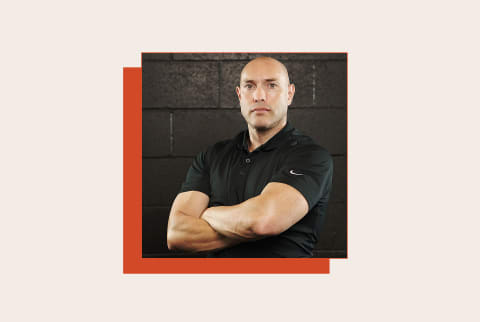Advertisement
5 Myths About Fat Loss You Have To Stop Believing, From An Exercise Scientist


The weight loss conversation is evolving for the better. We're no longer measuring success solely by the numbers on the scale. Instead, we're focusing on how to lose fat without sacrificing precious muscle mass.
According to exercise and nutrition scientist Bill Campbell, Ph.D., healthy fat loss boils down to one key principle: "We have to find things that we will actually do—and what we will actually do is the best prescription."
In this episode of the mindbodygreen podcast, Campbell offers evidence-based tips to lose fat and gain muscle simultaneously—including debunking these five fat loss myths:
Myth: It's all about cutting carbs
Carbohydrates have been vilified in peak diet culture, but not all carb-rich foods deserve this bad reputation. In fact, Campbell says the focus should be on increasing protein intake—specifically, about 0.75 gram per pound of body weight.
This range is ideal for those looking to lose fat or those in a calorie deficit, Campbell explains. "[Protein] is another anabolic nutrient or a stimulus that works synergistically with our resistance training to help maintain our muscle as we're dieting," he says.
While consuming 0.75 gram of protein per pound of body weight may seem daunting, Campbell suggests a tiered approach instead of starting with a hyper-calculated protein plan:
- Most important: "So the top, the most important thing you can do with protein is focus on the total number of grams you're going to eat in a day," he says. If you're new to tracking macros, it's going to be easiest to start by reaching your daily goal—that's it.
- A secondary goal: Once you have overall protein down, Campbell then recommends dividing up that total amount throughout the day between your meals and snacks or protein shakes.
- A final step to consider: Finally, if you have the first two tiers covered, you can schedule in one of your protein "feedings," as Campbell calls it, to align with your workout—either before or after you exercise.
Myth: Cardio is the best exercise for fat loss
If you hate cardio as much as I do, I have good news: It's not the only, nor the best, exercise for fat loss. The real winner is strength training, which Campbell also calls "the best anti-aging drug."
Cardio should be seen as a complementary workout. "Everybody should have some type of base cardio," Campbell advises, primarily to support cardiovascular health. This can include activities like speed walking, rucking, jogging, sprinting, biking, and more—that's right, it doesn't have to be running.
Find a type of cardio you enjoy and incorporate it into your strength training routine, but don't rely on it exclusively, Campbell says, especially if your goal is to maintain and build lean muscle mass.
Want the latest and greatest from leading well-being experts? Subscribe on Apple Podcasts.
Myth: You have to work out five days a week to lose weight
In an ideal scenario, I'd have unlimited time to hit the gym whenever I please, but realistically, that's not the case. I'd venture to say most people don't have that luxury.
However, according to Campbell, the key isn't necessarily hitting the gym five or six days a week but rather maximizing the time you do have and working around your own schedule.
"The No. 1 barrier to fat loss success is lack of adherence," he notes. Therefore, half the battle lies in creating a practical workout plan that you can realistically stick to.
Instead of focusing on specific days, consider aiming for a total number of sets each week divided over the days that fit into your schedule. For beginners or those at an intermediate level, Campbell recommends aiming for between 10-20 sets per week per muscle group.
Say you're right in the middle, aiming for 10 to 15 sets for each muscle group every week. This could look like:
- 2-3 sets, 5 times per week
- 5 sets, 2-3 times per week
- 5 sets, 2-3 times per week
The more sets you do, the longer your workout will take. But for those who have only two or three days a week they can exercise, this flexibility is paramount.
Know that in general, you want to work each muscle group at least twice a week, Campbell says, and go up from there. If you're completely new to strength training, he suggests starting with just one day a week and working your way up until your body gets used to the movement. This way, you avoid getting too sore or injuring yourself early on.
Myth: You have to cut your caloric intake in half to lose fat
To be clear, not everyone needs to cut calories—plenty of people (especially women) don't consume enough calories to even build muscle. However, Campbell says, if you have calories to spare and a desire to lose fat, a caloric deficit is a surefire way to get started.
Before you jump to the extreme, know this: You don't have to cut your calories in half to lose weight. Instead, Campbell recommends cutting back your caloric intake by 25% and focusing on getting 0.75 gram of protein per pound of body weight, as discussed above.
Myth: You have to load up on creatine to feel the difference
Creatine is finally gaining the recognition it deserves, being one of the most extensively studied supplements available. However, there's often confusion regarding the dosing approach—specifically, between a "loading phase" and a regular dose.
During the loading phase, individuals typically take 20 to 25 grams of creatine daily, split into smaller doses over five to seven days, to saturate their muscle stores before transitioning to a maintenance dose. But Campbell recommends opting for a lower dose with greater consistency: "PSA, just take 5 grams per day for the rest of your life," he says.
This approach ensures that you can continue benefiting from creatine without the need for loading phases or concerns about dosage changes over time.
The takeaway
When it comes to weight loss, gaining and maintaining muscle mass is just as important as losing excess body fat.
Skip the fad diets and cardio monotony and consider an approach that's focused more on strength training and protein intake–two major contributors to longevity and overall health, regardless.
For more muscle-building tips, listen to the episode on Apple Podcasts or watch on YouTube.
Watch Next
Enjoy some of our favorite clips from classes
Enjoy some of our favorite clips from classes
What Is Meditation?
Mindfulness/Spirituality | Light Watkins
Box Breathing
Mindfulness/Spirituality | Gwen Dittmar
What Breathwork Can Address
Mindfulness/Spirituality | Gwen Dittmar
The 8 Limbs of Yoga - What is Asana?
Yoga | Caley Alyssa
Two Standing Postures to Open Up Tight Hips
Yoga | Caley Alyssa
How Plants Can Optimize Athletic Performance
Nutrition | Rich Roll
What to Eat Before a Workout
Nutrition | Rich Roll
How Ayurveda Helps Us Navigate Modern Life
Nutrition | Sahara Rose
Messages About Love & Relationships
Love & Relationships | Esther Perel
Love Languages
Love & Relationships | Esther Perel
What Is Meditation?
Box Breathing
What Breathwork Can Address
The 8 Limbs of Yoga - What is Asana?
Two Standing Postures to Open Up Tight Hips
How Plants Can Optimize Athletic Performance
What to Eat Before a Workout
How Ayurveda Helps Us Navigate Modern Life
Messages About Love & Relationships
Love Languages
Advertisement

Your Grandma's Go-To Supplement Is Once Again Popular (For A Good Reason)
Molly Knudsen, M.S., RDN

8 Dietitians Share The Nutrition Advice They Actually Follow
Molly Knudsen, M.S., RDN

Want To Build Muscle After 60? Make Sure You Get Enough Of This (Not Protein)
Molly Knudsen, M.S., RDN

Your Grandma's Go-To Supplement Is Once Again Popular (For A Good Reason)
Molly Knudsen, M.S., RDN

8 Dietitians Share The Nutrition Advice They Actually Follow
Molly Knudsen, M.S., RDN

Want To Build Muscle After 60? Make Sure You Get Enough Of This (Not Protein)
Molly Knudsen, M.S., RDN

Your Grandma's Go-To Supplement Is Once Again Popular (For A Good Reason)
Molly Knudsen, M.S., RDN

8 Dietitians Share The Nutrition Advice They Actually Follow
Molly Knudsen, M.S., RDN

Want To Build Muscle After 60? Make Sure You Get Enough Of This (Not Protein)
Molly Knudsen, M.S., RDN

Your Grandma's Go-To Supplement Is Once Again Popular (For A Good Reason)
Molly Knudsen, M.S., RDN

8 Dietitians Share The Nutrition Advice They Actually Follow
Molly Knudsen, M.S., RDN

Want To Build Muscle After 60? Make Sure You Get Enough Of This (Not Protein)
Molly Knudsen, M.S., RDN












